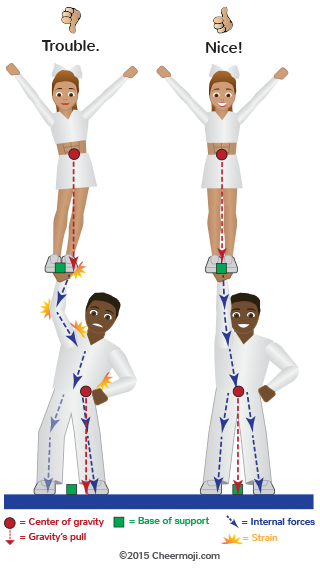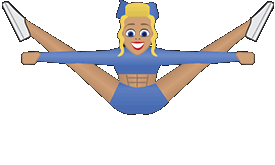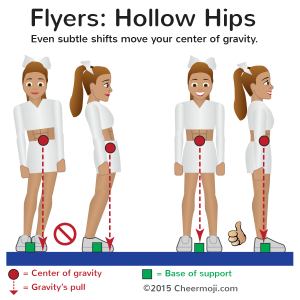A few years ago at college nationals, another coach asked me how we got our KU girls to stunt so clean. I’d seen his team’s routine, and they threw some great stuff, but he was right that even though they hit, they looked a bit rough.
What was the difference? How can two teams hit, but one somehow looks better?
It’s all about the lines. When a squad stunts with arms, chests, and/or legs at non-vertical angles, it won’t look as clean. And just as important, it’s less reliable and takes more effort to hold and hit. Understanding why and how to stunt with good lines will help you become a great stunter, so let me get a little sciency…
First, all objects – including people – have a “center of gravity” (shown by the red dots below) which is the central point where gravity (dashed red line) is pulling down on you. When you’re standing still, your center of gravity is a few inches inside your belly button. But repositioning your limbs, head, or chest moves your center of gravity – even to outside your body.
Second, every non-floating object also has a “base of support” (the green squares below), which is the mid-point of every part of you that’s touching the ground (or the bases’ hands).

Here’s the basics of a person’s center of gravity and how it moves based on their limb, head, and chest position.
Key #1 to great stunting is:
Flyers and Bases: Always keep your center of gravity straight over your base of support. Click To Tweet
The diagram above shows simple cases. But with stunting, even small non-vertical lines shift the center of gravity, often to the toes or side of the foot, forcing the bases to move to save the stunt.
This is another reason why flyers should “stunt still,” because every bobble and balance adjustment moves their center of gravity, making it harder for bases to stay under it.
Key #2 to great stunting:
Flyers, stunt still. Every movement shifts your center of gravity, making it harder for your bases. Click To Tweet
Lastly, your body is like a chain of bones. If the bones aren’t vertically aligned, gravity pulls down on them from different points, causing your muscles to strain (shown in yellow) to fight against your bones’ non-vertical internal forces (the blue dashed lines).
For flyers, that means things feel funky on the bases due to “torque” (which we won’t go into :). For bases, it means your muscles must work harder to hold the flyer, which is more tiring, less reliable, and increases the risk of joint injury. Stunt with your bones, not your muscles.

Non-vertical body lines cause all sorts of janky internal forces on your body parts, making it harder to hold the stunt.

Non-vertical body lines hurt in coed stunting even more because the base of support is narrower and there’s only one person to absorb the janky forces.
Key #3 to great stunting:
Bases: Stunt with vertical lines so your bones hold the weight, not your muscles. Click To Tweet
These keys are the building blocks of great stunting (pyramids too!). It gets a little more complicated with flipping and spinning, but focusing on vertical lines in the landing and catch will increase your chance of hitting.
I just learned the secret to great stunting from this article by @Cheermoji Click To Tweet
If you liked this post, sign up for these cheer and coach tips by email. Thanks!


